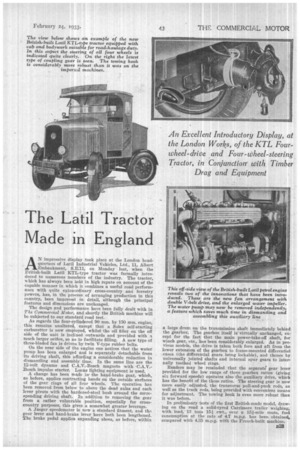The Latil Tractor Made in England
Page 37

If you've noticed an error in this article please click here to report it so we can fix it.
AN impressive display took place at the London headquarters of Latil Industrial Vehicles, Ltd., 11, Albert Embankment, S.E.11, on Monday last, when the British-built Latil KTL-type tractor was formally introduced to numerous members of the industry. The tractor, which has always been held in high repute on account of the capable manner in which it combines a useful road performance with quite extraordinary cross-country and forestry powers, has, in the process of arranging production in this country, been improved in detail, although the principal features and dimensions are unchanged.
The design and performance have been fully .dealt with in 'he Commercial Motor, and shortly the British machine will be subjected to our standard road test.
As regards the four-cylindered 90 mm. by 130 ram. engine, this remains unaltered, except that a Solex self-starting carburetter is now employed, whilst the oil filler on the off side of the unit is inclined outwards and provided with a much larger orifice, so as to facilitate filling. A new type of three-bladed fan is driven by twin V-type rubber belts.
On the near side of the engine one notices that the water pump has been enlarged and is separately detachable from it driving shaft, this affording a considerable reduction in dismantling and assembly time. In the same line are the 12-volt dynamo and C.A.V.-Bosch magneto with .C.A.V.Bosch impulse starter. Lucas lighting equipment is -used.
A change has been made in the hand-brake gear, which, as before, applies contracting hands on the outside surfaces of the gear rings of all four wheels. The operation has been removed from below to above the dead axles and each lever pivots with the hardened-steel bush around the corresponding driving shaft. In addition to removing the gear from a rather vulnerable position, especially for crosscountry purposes, this gives a somewhat greater leverage.
A. Jaeger speedometer is now a standard fitment, and the gear lever and hand-brake lever have both been lengthened. The brake pedal applies expanding shoes, as before, within
This off-side view of the British-built Latil petrol engine reveals two of the innovations that have been introduced. These are the new fan arrangement with double 17-belt drive, and the enlarged water impeller. The water pump may now be removed independently, a feature which saves much time in dismantling and
assembling this auxiliary line
a large drum on the transmission shaft immediately behind the gearbox. The gearbox itself is virtually unchanged, except for the fact that the main power-take-off shaft, for winch gear, etc., has been considerably enlarged. As in previous models, the drive is taken both fore and aft from the lower extension of the gearbox to frame-mounted differential cases (the differential gears being lockable), and thence by universally jointed shafts and internal spur gears to internally toothed wheel rings.
Readers may be reminded that the separate gear lever provided for the low range of three gearbox ratios (giving six forward speeds) operates also the auxiliary drive, which has the benefit of the three ratios. The steering gear is now more easily adjusted, the transverse pull-and-push rods, as well as the track rods, being provided with convenient means for adjustment. The towing hook is even more robust than it was before.
In preliminary tests of the first British-made model, drawing on the road a solid-tyred Carrimore trailer weighing, with load, 13 tons 151 cwt., over a 114-mile route, fuel consumption at the rate of 4.7 m.p.g. has been obtained, compared with 4.35 m.p.g. with the French-built machine.




























































































